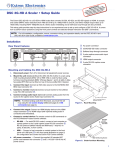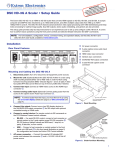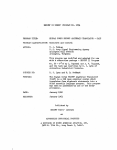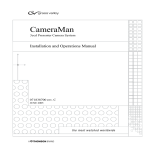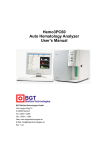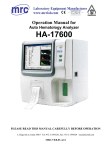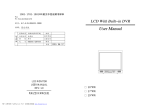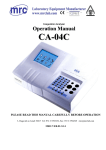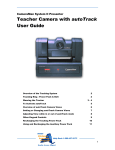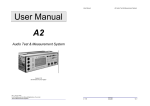Download CameraMan System II Presenter Specifications
Transcript
CameraMan 1-CCD Presenter Camera System Installation and Operation Manual L1203101 Rev D1 1999 Contacting Grass Valley Region Voice Fax Address Web Site North America (800) 547-8949 Support: 530-478-4148 Sales: (530) 478-3347 Support: (530) 478-3181 www.thomsongrassvalley.com Pacific Operations +852-2585-6688 Support: 852-2585-6579 +852-2802-2996 Grass Valley P.O. Box 599000 Nevada City, CA 95959-7900 USA U.K., Asia, Middle East +44 1753 218 777 +44 1753 218 757 France +33 1 45 29 73 00 Germany, Europe +49 6150 104 782 +49 6150 104 223 Copyright © Grass Valley. All rights reserved. Grass Valley Web Site The www.thomsongrassvalley.com web site offers the following: Online User Documentation — Current versions of product catalogs, brochures, data sheets, ordering guides, planning guides, manuals, and release notes in .pdf format can be downloaded. FAQ Database — Solutions to problems and troubleshooting efforts can be found by searching our Frequently Asked Questions (FAQ) database. Software Downloads — Software updates, drivers, and patches can be down- loaded. 2 CameraMan Installation and Operation Manual Table Of Contents I. Meet Your Presenter System • •••Congratulations on your Purchase . . . . . . . . . . . . . . . . . . . . . .1 • •••FCC Compliance Information . . . . . . . . . . . . . . . . . . . . . . . . . .1 • •••System Components . . . . . . . . . . . . . . . . . . . . . . . . . . . . . . . .2 • •••Main Docking Station Jacks and Switches . . . . . . . . . . . . . . . . .3 • •••Tracking Ring Package Jacks, Switches, and Assembly . . . . . . . .4 • •••Tracking System Keypad Buttons . . . . . . . . . . . . . . . . . . . . . . .5 II. Connect Your Presenter System • •••Installing the Camera System . . . . . . . . . . . . . . . . . . . . . . . . . .6 • Removing the CameraMan Connector Block • Mounting the Main Docking Station • Multi-Camera Application • •••Connecting to the Main Docking Station . . . . . . . . . . . . . . . . .7 • Connecting the CameraMan Cable • Connecting a Keypad/Controller • Connecting to the RS-232 Port • •••Tracking Ring Power Pack Assembly . . . . . . . . . . . . . . . . . . . . .8 • Tracking Ring Sensors III. Your Presenter System • ••• the Main Docking Station . . . . . . . . . . . . . . . . . . .9 • ••• the Tracking System Keypad . . . . . . . . . . . . . .10-11 • Tracking System Keypad • Understanding the Panning Motion • Re-Orienting the Pan Arrows • •••Other s . . . . . . . . . . . . . . . . . . . . . . . . . . . . . .12 • Maximum Pan/Tilt Travel • autoTRACK Windows IV. Use Your Presenter System • •••System Start-Up . . . . . . . . . . . . . . . . . . . . . . . . . . . . . . . .13-14 • Tracking Ring Package • Rechargeable Battery • Optional Auxiliary Battery Pack • Audio Switch • •••Using autoTRACK . . . . . . . . . . . . . . . . . . . . . . . . . . . . . . . . .15 • •••Using autoTRACK Views . . . . . . . . . . . . . . . . . . . . . . . . . .16-18 • •••Using the Subject Position and Pan/Tilt Arrows . . . . . . . . . . . .19 • •••Using autoFIND and Tracking Freeze . . . . . . . . . . . . . . . . . . .20 • •••Using Location Presets . . . . . . . . . . . . . . . . . . . . . . . . . . . . .21 • •••Controlling the Zoom, Focus and IMAGE . . . . . . . . . . . . . . . .22 V. Setting Up Gen Lock with Your Tracking System Keypad • •••Gen Lock Setup . . . . . . . . . . . . . . . . . . . . . . . . . . . . . . . .23-24 VI. Appendices • •••A:Troubleshooting . . . . . . . . . . . . . . . . . . . . . . . . . . . . . .25-27 • •••B: and Clearance Diagram . . . . . . . . . . . . . . . . .28 • •••C: Pinout Connections . . . . . . . . . . . . . . . . . . . . . . . . . . . . . .29 • •••D: Typical System Setup . . . . . . . . . . . . . . . . . . . . . . . . . . . .30 • •••E: Glossary of Terms . . . . . . . . . . . . . . . . . . . . . . . . . . . . . . .31 CameraMan® 1-CCD Presenter Camera System Installation and Operations Manual Congratulations On Your Purchase! Your new Presenter Camera System uses proven automatic tracking technology to improve your distance learning, telemedicine, and videoconferencing applications. Use this manual with the 1-CCD General Pan/Tilt Camera System Installation an Operations Manual that came with your CameraMan 1-CCD camera. This manual covers the connection, configuration, and usage of your new Presenter Camera System. Along with basic pan, tilt, zoom, and IMAGE control of your CameraMan camera, the Presenter Camera System boasts advanced features and functionality. The system comes with an input/output Main Docking Station, the Tracking Ring Package with built-in microphone, and the wireless RF (or hard-wired) Tracking System Keypad from which autoTRACK Views and other tracking functions are controlled. All are covered in this manual. If you have questions regarding the installation or operation of your CameraMan 1-CCD General Pan/Tilt camera, refer to the Installation and Operations Manual included with the camera. You will see three icons throughout this manual: This icon alerts you to important instructions in the operation and maintenance of your Camera Control Keypad. This icon alerts you to tips or noteworthy suggestions in the operation, use or maintenance of your Camera Control Keypad. This icon refers you to the 1-CCD Camera Installation and Operations Manual that came with your camera. The manufacturer reserves the right to change specifications and warranty at any time without notice or obligation. Refer all Warranty and Servicing to Product Support. No part of this manual may be copied or reproduced without express written consent of Grass Valley. d Your 1-CCD Presenter Camera System should include these components: • One 1-CCD Main Docking Station • One 10’ Main Docking Station Cable • One Tracking Ring Power Pack • One Tracking Ring Sensor • One Tracking Ring Belt • One Power Pack Charger • One 1-CCD Tracking System Keypad • One 1-CCD Presenter Camera System Operations Manual • One 1-CCD Tracking Ring Package Quick Reference Card • One Tracking Ring Power Pack Pouch FCC Compliance Information This equipment has been tested and found to comply with the limits for Class A digital devices, pursuant to Part 15 of the FCC Rules. These limits are designed to provide reasonable protection against harmful interference when the equipment is operated in a commercial environment. This equipment generates, uses, and can radiate radio frequency energy and, if not installed and used in accordance with this manual, may cause harmful interference to radio communications. Operation of this equipment in a residential area is likely to cause harmful interference in which case the user will be required to correct the interference at their own expense. This unit was tested with shielded cables on the peripheral devices. Shielded cables must be used with the unit to insure compliance. Grass Valley is not responsible for any radio or TV interference caused by unauthorized modifications to this equipment. Such modifications could void the user’s authority to operate the equipment. DURACELL® is a registered trademark of Duracell, Inc. Meet Your 1-CCD Presenter Camera System Page 1 Presenter System Components The Presenter Camera System comes with various pieces that use both infrared and RF autoTRACK technology to enable the CameraMan to follow you around the room automatically. If you have purchased this as an upgrade, your package will include all the necessary components except the camera. Product Description The Presenter Camera System consists of the following components: Main Docking Station The Main Docking Station is the I/O center of your Presenter Camera System. It comes standard with two RF frequencies (alternate channels are available for special order). After you connect it to your CameraMan camera, you can control the camera’s video and audio output, as well as it’s movement via the tracking ring, tracking keypad, or another external control device. The Main Docking Station consists of: 1 V •1 • Main Docking Station with two antennas •2 • 10’ multi-conductor cable with 37-pin D-sub connectors Tracking Ring Package The Tracking Ring Package uses patented autoTRACK™ technology to communicate with your CameraMan camera. By wearing the Tracking Ring, you can move freely around the room while the camera automatically follows your every move. This gives you the freedom to get up from the conference room table and walk to a flip chart without being dependent on a human camera operator or a system with a fixed or static-view camera. The Tracking Ring Package consists of: •3 •4 •5 •6 •7 • Tracking Ring with built-in microphone • Tracking Ring Power Pack with a built-in 12-hour Rechargeable Battery • Tracking Ring Power Pack Belt • Battery Charger • Tracking Ring Power Pack Pouch 2 V 3 V 5 V 4 V 7 V Tracking System Keypad The Tracking System Keypad •8 •lets you control camera features such as autoTRACK Views, location presets, gen lock setup, and manual pan/tilt functions in either a wireless RF or a hard-wired mode. With icons illustrating every autoTRACK View button, you can easily understand what each camera view should look like. Also available (sold separately) Auxiliary Battery Pack (24 hour) Page 2 6 V CameraMan® 1-CCD Presenter Camera System Installation and Operations Manual 8 V Main Docking Station Take a look at the back of your Main Docking Station. The diagram below shows the various connections and configuration switches. 1 ANTENNA – RF receivers for the tracking power pack. V 5 S-VIDEO VIDEO OUT JACK – Provides direct S-Video video output V V RF CHANNEL SELECT – Used to select which RF channel the Main through standard mini-DIN jack (cable not provided). SS 2 Docking Station will use to communicate with the Tracking Ring Package. V AUDIO: LEVEL SWITCH – Used to configure the level of the balanced 6 COMPOSITE VIDEO OUT JACK – Provides direct composite video output V through standard BNC-type jack (cable not provided). 3 audio (XLR) output, available for either LINE or MIC level, depending on the type of audio system interfacing with the CameraMan system. The unbalanced output is LINE only. 7 RS-485 IN and OUT JACKS – 4-position modular handset jacks used for V RS-485 communications between the camera system and other CameraMan devices. 4 AUDIO: LEVEL ADJUST – Used to fine tune the level of the audio V outputs.. 1 V 1 V 3 4 V V 2 V 7 V 8 9 V V 10 V 8 PVI COM JACK – 6-conductor RJ-11 jack used for communication with the V Tracking System Keypad in hard-wired mode. 9 RS-232 PORT – Standard DB-9 (female) connector provides RS-232 V communications capability for devices like PCs or other vendor-control systems. 10 AUXILIARY COMMUNICATIONS PORT A – Provides communications to V select CameraMan peripherals. Do not use unless otherwise specified. 12 11 V V 6 5 V V 13 V 14 V 12 AUDIO: UNBALANCED JACK – Standard RCA-type connector provides V unbalanced, line level only mono audio output to connect to a standard mixer or similar audio equipment. 13 BASE UNIT PORT – 37-pin D-sub connector provides communication V between the Main Docking Station and the Camera System via a 10’ multiconductor cable . 14 DC POWER – Power input for the Main Docking Station. V 11 AUDIO: BALANCED JACK – Standard XLR-type connector provides V balanced line or mic level audio output to connect to a standard mixer or similar audio equipment. Meet Your 1-CCD Presenter Camera System Page 3 Tracking Ring Package Before connecting or using your Tracking Ring package, take a moment to learn about the various buttons, switches, and jacks. Power Pack VPOWER INDICATOR LED – Lets you know when power is ON (red) and when batteries are LOW (yellow). VTRACKING RING PORT – Used to connect Tracking Ring to power pack (see page 13). top view of power pack VAUXILIARY BATTERY PACK PORT – Used to connect the optional auxiliary battery pack for extended use (see page 14). VPOWER SWITCH – Used to turn power pack and Tracking Ring on and off. VAUDIO SWITCH – Used to turn Tracking Ring’s microphone on and off. VCHARGER PORT – Used to connect battery charger to power pack. VRF CHANNEL SWITCH – Used to select the RF channel the power pack will use to communicate with the Docking Station (MUST be the same as the Docking Station). Tracking Ring Assembly Back Sensor Belt Assembly Clip Front Sensor/Mic Tracking Ring Port Connector Antenna Page 4 CameraMan® 1-CCD Presenter Camera System Installation and Operations Manual Clip power pack pouch on belt as shown Tracking System Keypad Next, take a look at the front of your Tracking System Keypad. It is the control center for your Presenter Camera System and contains the following features. VIndicator LED – indicates Keypad is in operation. VSUBJECT POSITION CONTROLS – Used to fine-tune the position of the subject while in autoTRACK mode. V LOCATION PRESET SELECT – Used to recall preset locations. VTRACKING FREEZE – Used to disengage autoTRACK, and freeze the camera’s movement. VautoTRACK VIEWS – Used to change the position and perspective of the presenter in the video frame while being tracked by the camera (choose between Tight, Wide, Right, and Left) VSETUP – Used in conjunction with other controls for advanced functions. VIMAGE CONTROLS – Used to open and close the iris. VautoIMAGE – Used to allow the camera to automatically adjust the brightness and darkness for each video picture. VZOOM IN/OUT – Used to tighten and widen the camera’s view. VPAN/TILT – Used to Controls the camera’sup/down, and left/right movement. Use of the PAN/TILT arrow buttons will disengage the autoTRACK mode. VFOCUS – Used to manually adjust visual clarity of the video picture. Used with SETUP button to increase and decrease Gain. VautoFOCUS – Used to allow the camera to automatically adjust the visual clarity of the video picture. Meet Your 1-CCD Presenter Camera System Page 5 Installing the Camera System Now that you’ve identified the components of your Presenter Camera System, as well as their individual buttons, ports, and jacks, you can begin connecting them to your CameraMan camera. Removing the CameraMan Connector Block (Upgrade Only) If you are performing initial installation of a system package, as opposed to an upgrade, this will not be necessary. Three screws through connector plate Connector Plate To remove the CameraMan Connector Block: 1. Turn OFF the POWER switch on the back of the Camera. 2. Disconnect all cables from the back of the camera. 3. Remove the screws which hold the connector block in place. 4. Pull outward on the connector block, unplugging it from the DB-37 connector. The Main Docking Station cable will plug into this port. Mounting the Main Docking Station The Main Docking Station can be mounted with any orientation, but it must be mounted within 10' (but not closer than 1’) of the autoTRACK Camera (use only the supplied CameraMan cable to connect the two units). Mount the Main Docking Station using the following guidelines: 1. Mount the Main Docking Station in the desired location. Be sure to leave sufficient space for access to the connections on the back panel. 2. Verify that the POWER switch on the front of the Main Docking Station is turned OFF. 3. Mount or place the CameraMan Power Supply in a convenient location near the autoTRACK Docking station. 4. Plug the 5.5mm female connector from the power supply cord into the DC POWER jack in the back of the docking station. 5. Plug the other end of the power supply into a 120 VAC outlet. 6. Connect the antennas to the appropriate connectors and position them so that they both point in a vertical direction for optimum performance. DB-37 connector Back of Main Docking Station For best performance, locate the antennae in free space, at least 6" from the camera, or any wires, metal surfaces, wall, etc. See the Main Docking Station Clearance diagram on page 28. Multi- Camera Applications In a multi-camera application where it is desired to network multiple Cameras together, refer to the multi-camera section of the 1-CCD General Pan/Tilt Installation and Operations Manual. Follow the appropriate procedure, using the RS-485 connections on the back of the Main Docking Station instead of the connections on the back of the Camera. Page 6 CameraMan® 1-CCD Presenter Camera System Installation and Operations Manual Installing two Tracking Systems in the same area will cause unpredictable results. Connecting to the Main Docking Station Now you can begin connecting your Main Docking Station to your CameraMan Camera System and your camera control devices. Connecting the CameraMan Cable The Presenter Camera System provides for RS-232 communications using the DB-9 jack on the back of the Main Docking Station labeled RS-232. This RS-232 port can be used to control the CameraMan camera from external devices such as a PC or other vendor-control system (i.e.: AMX, Crestron). Connect to this port using a standard computer cable with a DB-9 connector. This port operates at 9600 baud (19,200 with CameraMan SHOT Director), No Parity, and software hand-shaking using CameraMan High-Reliability or Basic protocols (High Reliability only with SHOT Director). The LED located above the RS-232 port is used to indicate communication activity. If 9600 baud rate is selected, BASIC PROTOCOL must be selected as well. - + AUX. A 2 01 3 LANC BA AUXILIARY POW ER S-VIDEO I SI ON SW ITCH BANK -A- SW ITCH BANK -BCOM POSITE M AIN DOCKING STATION 12 34 567 8 BASE UNIT ADDRESS 1 23 45 67 8 TALLY LIGHT IN TERFACE UP DOW N multi-conductor cable connection: up to 10’ PROTOCOL configuration switch Verify which protocol is being used by checking the PROTOCOL switch (switch bank B – switch 1) on the back of the CameraMan camera. For more information on setting the protocol on your CameraMan camera, see the Installation and Operations Manual that came with the camera. Connect Your 1-CCD Presenter Camera System COMPOSITE VIDEO OUT TO CAMERA RS-232 connection to PC or other control device (If desired) 67 45 8 PAR KER S-VIDEO OUT A U D I O UN RS-232 EF Connecting to the RS-232 Port L E VE L MIC BALAN CE D CD Using cable other than a supplied cable for the PVI COM port may cause damage. The Tracking System Keypad can be hard-wired up to a maximum distance of 250’. LINE Made in USA Connecting a Keypad/Controller If desired, the Tracking System Keypad can be hard-wired to the Main Docking Station using a CameraMan Keypad Cable (provided). 1. Connect one end of the cable to the RJ-11 type jack located in the battery compartment of the keypad. (Remove batteries) 2. Connect the other end of the cable to the RJ-11 type jack on the back of the Main Docking Station, labeled PVI COM. 3. Look at the LED on the keypad, which should illuminate momentarily, indicating that the keypad is ready for operation. ANTENNA 1 P ARKER ISION ® RF CHANNEL PVI COM RS-485 OUT 9A B Verify that the CameraMan Cable is supported in such a manner that the camera does not drag the cable as it moves. If the camera drags the cable, then the performance of the system may be compromised. ANTENNA 2 RS-485 IN ED The autoTRACK Camera connects to the Main Docking Station using the supplied CameraMan 10' multi-conductor cable with DB-37 connectors on both ends. 1. It is important to verify that the POWER switch on the front of the Main Docking Station is turned OFF before making this connection. 2. Connect the DB-37 male connector to the back of the CameraMan camera and secure the connection using the two connector screws located on the cable connector. This will ensure that the cable will not become dislodged due to the motion of the CameraMan camera. PVI COM 3. Connect the other end of the CameraMan cable to the MULTI-PIN connector on the back connection: of the Main Docking Station. up to 250’ Page 7 DC POWER Tracking Ring Power Pack Assembly Now you are ready to assemble the Tracking Ring Package and learn how to wear it properly to ensure that your CameraMan camera follows you around the room. Tracking Ring Power Pack Assembly Using the clip on the back of the puch, attach the Tracking Ring Power Pack either directly to your clothing by clipping it to your waistline or skirt or to the Tracking Ring Power Pack Belt. The Tracking Ring Power Pack must be worn so that the antenna hangs loosely. Do not place the Power Pack in your pocket. This interferes with the RF signal and may affect the audio and tracking capability. antenna should hang loosely Tracking Ring Sensors 1. Identify the sensors: • Front Sensor: equipped with a built-in microphone and tracking sensor. It is identified by the main connector to the Power Pack. • Back Sensor: equipped with the built-in tracking sensor only. 2. Slip the Tracking Ring around your neck. 3. Clip the Tracking Ring strap closed to form a complete circle around your neck. 4. Verify that the Front Sensor is lying flat and centered, just above chest level, and that the Back Sensor is lying flat on the back of your collar. 5. Plug the Tracking Ring Sensor Assembly connector into the port on the top of the Tracking Ring Power Pack. Ensure that the sensors lie flat on the front and back The Front and Back Sensors require a direct line-of-sightlink with the camera. The presenter must exercise caution to ensure that no clothing or hair covers either Sensor. About the sensors It is important to understand exactly how the autoTRACK Tracking Sensors work to obtain the maximum performance levels. The autoTRACK mode is an exclusive feature that enables the the camera to automatically track the subject wearing the Tracking Ring Package. Ensure that no hair or article of clothing covers the Tracking Sensors Since the Tracking Sensors require a direct line-of-sightlink with the camera, the subject must exercise caution to ensure that no clothing or hair covers the Sensors. This will ensure constant communication with the CameraMan camera. The Front Sensor should be lying flat and centered on the body, just above chest level. The Back Sensor should lie flat against the back of the collar or neck. When a presenter turns around to point to a flipchart, for example, the Back Sensor continues to receive the infrared tracking signal from the camera. With the proper positioning of the sensors, the CameraMan camera provides 360° of coverage for the presenter wearing the Tracking Ring Package. Page 8 CameraMan® 1-CCD Presenter Camera System Installation and Operations Manual Back Sensor Front Sensor Configuring the Main Docking Station Before you can begin to use your new Presenter Camera System, you need to configure its components. There are two settings on the back of the Main Docking Station which must be set as follows: 1. Set the RF CHANNEL switch to the desired channel. This must match the setting on the Tracking Ring Power Pack. If you experience any problems on one of the channels, switch both to the alternate channel. (Factory Default: UP position/one dot) 2. Set the AUDIO LEVEL switch to the desired audio output. • To have a mic-level audio signal, set this switch to MIC. • To have a line-level audio output, set this switch to LINE. • This switch setting will apply to the balanced audio output only. (Factory Default: MIC) Step 1: RF Channel Switches must match Step 3: Audio Level Adjust Step 2: Audio Level Switch 3. Set the AUDIO LEVEL ADJUST to the desired volume level. The default setting is zero (0)dbm. Refer to Appendix B for specifications on the audio outputs. Powering Up Main Docking Station ON Before you can configure the rest of your Presenter Camera System, you need to turn the system power ON. Switch ON the POWER button on the front of the Main Docking Station. The CameraMan camera should automatically enter its position calibration mode and then stop at the 0° Pan/0° Tilt position. Verify that the base is now facing in the direction you pointed the FRONT label when mounting. This label is located on the bottom of the camera unit. POWER OFF Main Docking Station Power Switch For more information on mounting the CameraMan, see the Installation and Operations Manual that came with the camera. Configure Your 1-CCD Presenter Camera System Page 9 Configuring the Tracking System Keypad Tracking System Keypad Check the KEYPAD ADDRESS rotary switch in the battery compartment of the keypad and verify that the selected setting corresponds to the setting of the BASE UNIT ADDRESS switch on the back of the autoTRACK Camera. If they are different, then adjust them to match. For more information on configuring the BASE UNIT ADDRESS on the camera and keypad, see the Installation and Operations Manual that came with the camera. Battery compartment Keypad Address If the Tracking System Keypad is being used in the wireless RF mode: 1. Install the supplied AA batteries in the Tracking System Keypad by removing the battery door and inserting the batteries into the battery compartment, as indicated. 2. Once the batteries are installed, replace the battery door and press one of the pan keys. 3. Verify that the LED on the front of the keypad illuminates. This indicates that the batteries are installed properly. If the LED does not illuminate, then the batteries may be installed backward. Reverse the way the batteries are inserted and try again. ANTENNA 2 P ARKER ISION RF CHANNEL RS-485 OUT PVI COM MIC - + AUX. A 2 01 3 DE F CameraMan® 1-CCD Presenter Camera System Installation and Operations Manual 67 8 C Refer to pages 15 through 22 for details on using the Tracking System Keypad. 45 9 AB Press the PAN and TILT arrows (one at a time) and verify that the camera is responding to the keypad. The COM LED on the front of the camera should flash with every command received by the camera. If the autoTRACK LED on the front of the camera is not illuminated, then press one of the four autoTRACK View buttons on the keypad. This should cause the autoTRACK LED to begin flashing. LANC BA ED Tracking System Keypad in hard-wired mode S-VIDEO OUT A U D I O UN RS-232 Remove the batteries installed in the Tracking System Keypad when it is being used in the hard-wired mode. Page 10 LINE BALAN CE D If the batteries are inserted improperly, it will not damage the keypad, the keypad simply will not work. If the Tracking System Keypad is being used in the hard-wired mode, connect one end of the CameraMan Keypad Cable to the RJ-11 type jack located in the battery compartment of the Tracking System Keypad. Connect the other end of the cable to the Main Docking Station jack labeled PVI Com. L E VE L ® Made in USA C TO CAMER Configuring the Tracking System Keypad You can control the CameraMan camera’s panning motion with either the PAN/TILT arrows on the bottom or, when using autoTRACK, the SUBJECT POSITION arrows on the top of your Tracking System Keypad. Understanding how the camera moves will help you stay in control of your presentations. Modification of the following features is not required for system operation, but they are available if needed. For information on configuring your CameraMan camera, refer to the Installation and Operations Manual that came with the camera. Example 1 (Default setting): Facing toward the camera so you are seeing yourself. The camera sees you. Understanding the Panning Motion The PAN/TILT and SUBJECT POSITION arrows on your Tracking System Keypad are designed to help you maneuver the camera both in and out of autoTRACK mode. The default setting, shown in Example 1, is designed to operate as if you are facing the CameraMan camera. Some examples of applications that would benefit from the default settings are: • Distance Learning where you are the instructor. • Presentations where you are presenting to an audience watching you on a monitor. • Videoconferences where the you are an on-screen participant. • Any other application where you, the keypad controller, need to be on camera. There are applications, however, in which you do not need to face the camera (example 2), so the default setting will not work. You find that when you want the camera to move right, the picture moves left. These applications require you to re-orient the PAN arrows (see below). Some examples of applications that might benefit from this re-orientation are: • Presentations where you are not presenting but are controlling the camera’s movement. • Videoconferences where you are a moderator, but not an on-screen participant. • Applications where you are in a control room controlling the camera. • Any other application where you, the keypad controller, do not need to be on camera. Your line of sight Example 2: Facing away from the camera so you see the talent, or on-screen participants. The camera sees what you see. Re-Orienting the Pan Arrows To re-orient (reverse) the default setting of the pan arrows on your Tracking System Keypad, use the following simple procedure: 1. Press the TRACKING FREEZE and SETUP buttons simultaneously. 2. After about two seconds, the keypad will beep. Your line of sight 3. Release the buttons. This will also reverse the operation of the SUBJECT POSITION arrows. Configure Your 1-CCD Presenter Camera System Page 11 Other Configurations The following configurations, like the panning orientation, would apply to your specific application need. Before changing the autoTRACK Window size, you need to power up the tracking ring package. Refer to page 13. Maximum Pan/Tilt Travel Once the CameraMan Camera is installed,you can configure the maximum PAN/TILT settings to suit the application.The CameraMan camera has a maximum pan range of 359°, but comes programmed with factory default settings of ± 90° of PAN and ±25° of TILT. If desired, use the following procedure to change the maximum position settings: 1. Press and hold the SETUP button. 2. Press and hold one of the PAN/TILT arrows until achieving the desired maximum position. 3. Release the SETUP button. 4. Listen for two beeps, indicating that the maximum position for that direction has been set. Setup Button Pan/TIlt Arrows 180° Default Pan Settings 359° Maximum Pan Settings 50° Default Tilt Settings autoTRACK Windows Invisible autoTRACK Window Each autoTRACK View includes a pre-programmed window. This window is an invisible area around the presenter where the Tracking Ring’s movement will not cause CameraMan to PAN or TILT. Once the presenter decides to move in a direction outside of the invisible autoTRACK window, the CameraMan continues to autoTRACK. This eliminates unnecessary camera motion, which provides better picture quality for videotaping and minimizes the amount of updating necessary at lower CODEC update rates in videoconferencing applications. Each autoTRACK View has a preprogrammed window. Each window is set at a predetermined factory default and in most applications does not need to be adjusted. Video Frame autoTRACK View Buttons Proper window sizes are factory-determined for the best results. Grass Valley recommends the window size not be altered or adjusted. If a change in Window size is absolutely necessary: 1. Press and release the desired autoTRACK View button. 2. Press and release both the SETUP and the desired SUBJECT POSITION arrow simultaneously as follows: Left arrow Decrease Pan window Right arrow Increase Pan window Down arrow Decrease Tilt window Up arrow Increase Tilt window 3. Press and hold the selected autoTRACK View button until you hear 2 beeps indicating the new window size has been set. Page 12 CameraMan® 1-CCD Presenter Camera System Installation and Operations Manual Subject Position Arrows Setup Button All user-adjusted settings may be removed by resetting the camera to “Fctory Defaults.” To reset the camera unit to “Factory Defaults,” simultaneously press autoTRACK TIGHT and autoTRACK LEFT for 1-2 seconds, and relese. System Start Up Once you have made all the necessary connections and configurations, you are ready to start up the rest of the system. Top view of Power Pack llustrating power switch and ON LED Tracking Ring Package 1. Power ON the CameraMan camera with the POWER switch on the Main Docking Station. 2. Set the Tracking Ring Power Pack's power switch, located on the top of the unit, to the ON position. The Power ON LED on the Power Pack illuminates. If the Power ON LED on the top of the Tracking Ring Power Pack does not illuminate, then refer to the Troubleshooting section of this manual. 3. Verify that the TRACKING UNIT STATUS LED on the camera’s display panel illuminates, indicating the communication link between the camera and the Tracking Ring. 4. Press one of the four autoTRACK View buttons on the keypad to activate the autoTRACK functionality of the Camera System (the camera will not track until one of the autoTRACK buttons is pressed). Once you are in autoTRACK mode, the autoTRACK LED on the camera’s display panel illuminates. If the autoTRACK LED on the CameraMan’s display panel is blinking, CameraMan is in the autoTRACK mode, but the link between CameraMan and the Tracking Ring is not active. autoTRACK View buttons on Keypad CameraMan display panel tracking LEDs (ON when active) To establish this link, move into the CameraMan’s field-of-view (Please see the autoTRACK MODE or Troubleshooting sections of this manual for further assistance). Top view of Power Pack illustrating battery LOW LED Rechargeable Battery The Tracking Ring Power Pack comes with a built-in 12-hour Rechargeable Battery. When the battery is running low, the Battery LOW LED on the top of the Tracking Ring Power Pack illuminates. At this time the Tracking Ring Power Pack should be recharged or an Auxiliary Battery Pack should be attached to the Tracking Ring Power Pack. To recharge the battery: 1. Turn OFF the Tracking Ring Power Pack. 2. Set the switch on the front of the Battery Charger to TRACKING POWER PACK. 3. Plug the Battery Charger into an electrical outlet and connect the Power Pack to the charger. The Battery Charger takes 2 to 3 hours to recharge the Tracking Ring Power Pack. Tracking Power Pack switch on back of battery Top view of Power charger Pack illustrating battery charger jack The LED on the Battery Charger indicates when the battery is fully-charged. If a battery is very low, then the LED on the charger flashes slowly. While the battery is charging, the LED on the charger stays on. When the battery is fully-charged, the LED on the charger flashes faster. Use Your 1-CCD Presenter Camera System Page 13 System Start Up Optional Auxiliary Battery Pack An optional Rechargeable Auxiliary Battery Pack is available to connect with the Tracking Ring Power Pack for extra long use. When attached to the Tracking Ring Power Pack, the Auxiliary Battery Pack overrides the built-in 12-hour Battery. If more than 4 hours of use is required, then connect the Auxiliary Battery Pack to the Tracking Ring Power Pack. This provides up to twentyfour additional hours of use. To recharge the Auxiliary Battery Pack: 1. Turn OFF the Tracking Ring Power Pack. 2. Set the switch on the front of the Battery Charger to AUXILIARY BATTERY PACK. 3. Plug the Battery Charger into an electrical outlet and connect the Auxiliary Battery Pack to the charger. To get the maximum hours of use, utilize the 12 hour built-in battery first until the Battery LOW LED illuminates, then attach the Auxiliary Battery Pack for an additional 24 hours, giving you a total of 36 hours of use. Once the BATTERY LOW LED illuminates, recharge the Tracking Power Pack before the next use. The Battery Charger takes 4 – 6 hours to recharge the Auxiliary Battery Pack. Audio Switch To activate Audio: 1. Set the AUDIO switch on the top of the Tracking Ring Power Pack to ON. 2. Speak at a normal level. If you decide not to use the Audio feature of the Tracking Ring Package, the AUDIO switch on the top of the Tracking Ring Power Pack should be set to OFF. Page 14 CameraMan® 1-CCD Presenter Camera System Installation and Operations Manual Auxiliary Battery Pack plugged into Power Pack and mounted on Tracking Ring Power Pack Belt Auxiliary Battery Pack switch on battery charger Top view of Power Pack illustrating audio switch and ON LED Using autoTRACK Your Presenter Camera System’s ability to follow a presenter around the room is unmatched in the industry. Now that you’ve connected, configured, and powered up all the system components, you can begin to put them to use. autoTRACK Mode autoTRACK mode enables the CameraMan camera to follow a presenter wearing the Tracking Ring Package automatically. To engage the autoTRACK mode, simply press one of the four autoTRACK View buttons on the Tracking System Keypad. If you are using a Deluxe Camera System which includes Personal Locator Keypads, use the following procedure: 1. When you are ready to begin autoTRACKing, press LOCK on the Chairperson Locator Keypad to disable all Personal Locators from controlling the camera. 2. Press one of the four autoTRACK buttons on the Tracking System Keypad. 3. When you are finished autoTRACKing, press UNLOCK on the Chairperson Locator Keypad. This will re-enable the Personal Locator Keypads. For more information on the Personal Locator Keypads, see the CameraMan Personal Locator System Operations Manual. If the LOCK button is not used and a MY TURN button is pressed while autoTRACKing, the system will disengage the autoTRACK mode and go to the MY TURN position. The autoTRACK mode’s operation requires the subject to be in the field-of-view of the autoTRACK Camera. Once the subject enters the field-of-view, the camera moves to lock onto line-of-sight tracking. If the subject becomes obscured from its line-of-sight, the camera will stop tracking and return to the HOME position (see page 21). However, momentary breaks (ie- someone walking through the line-of-sight) will have minimal effects on the tracking performance. 100° Field-of-view Once the subject enters the field-of-view... ...the CameraMan camera moves to lock onto the line-of-sight tracking Presenter Line-of-sight Presenter Use Your 1-CCD Presenter Camera System Page 15 Using autoTRACK Views One of the keys to your Presenter Camera System is its ability to not only track you around the room, but to memorize various views and presets. These help you make more effective and dynamic presentations. autoTRACK Views Overview You can choose from four autoTRACK Views to engage the autoTRACK mode. You can store and recall these views from the Tracking System Keypad by pressing one of the autoTRACK View buttons. For example, when you make a presentation, you can change from a close head shot with the TIGHT autoTRACK View button to emphasize facial expressions, to a full-body shot by pressing the WIDE autoTRACK View button. Presenters can also share the video screen with a flipchart or other key presentation areas with the LEFT or RIGHT autoTRACK View buttons. Tight autoTRACK view Each autoTRACK View will store and recall a ZOOM perspective with an IMAGE setting. Changes in the Subject’s Position within the video frame can also be stored. These functions enable the subject to fine-tune their position in each of the autoTRACK Views. For example, you may want to zoom-in slightly closer on the WIDE autoTRACK View or adjust your position in the video frame more to the left or right. This provides you with the flexibility to customize each autoTRACK View to suit your needs. Wide autoTRACK view You can reset the autoTRACK Views to accommodate these changes using the procedures on the following pages. Right autoTRACK view Left autoTRACK view Page 16 CameraMan® 1-CCD Presenter Camera System Installation and Operations Manual Using autoTRACK Views TIGHT autoTRACK View Press and release the TIGHT autoTRACK View button. The video frame should show a close head shot of you. This view is used to emphasize facial expressions. If you would like to alter your image in this view, then you need to reset the Tight autoTRACK View. To SET or CHANGE the tight autoTRACK View: 1. After pressing the TIGHT View button, use the SUBJECT POSITION arrow buttons to position yourself in the middle of the video frame. 2. Only when desired, use the manual ZOOM and FOCUS buttons to set the needed zoom perspective. 3. Only when desired, use the manual IMAGE (Iris and Gain) buttons to set the needed light/dark contrast. 4. Press and hold the TIGHT button until you hear two beeps indicating the new setting has been stored. Step 4 Step 1 Step 3 Step 2 To RECALL the tight autoTRACK VIEW: Press and release the TIGHT View button. The CameraMan then recalls the information stored in the TIGHT button. WIDE autoTRACK View Press and release the WIDE autoTRACK View button. The video frame should show a wide body shot of you. If you would like to alter your image in this view, then you need to reset the Wide View. To SET or CHANGE the wide autoTRACK VIEW : 1. After pressing the WIDE View button, use the SUBJECT POSITION arrow buttons to position yourself in the middle of the video frame. 2. Only when desired, use the manual ZOOM buttons to set the needed zoom perspective. 3. Only when desired, use the manual IMAGE buttons to set the needed light/dark contrast. 4. Press and hold the WIDE button until you hear two beeps, indicating the new setting has been stored. Step 1 Step 4 Step 3 Step 2 To RECALL the wide autoTRACK VIEW: Press and release the WIDE View button. The CameraMan then recalls the information stored in the WIDE button. Use Your 1-CCD Presenter Camera System Page 17 Using autoTRACK Views RIGHT autoTRACK View Press and release the RIGHT autoTRACK View button. Your image should now be offset to the right side of the video frame. Use this view when the presenter wants to share the video screen with key presentation areas (a presenter who is left-handed may use this view while pointing to a flipchart). If you would like to alter your image in this view, then you need to reset the Right View. Step 1 Step 4 Step 3 To SET or CHANGE the right autoTRACK VIEW: 1. After pressing the RIGHT View button, use the SUBJECT POSITION arrow buttons to position yourself to the desired location in the video frame. 2. Only when desired, use the manual ZOOM buttons to set the needed zoom perspective. 3. Only when desired, use the manual IMAGE buttons to set the needed light/dark contrast. 4. Press and hold the RIGHT button until you hear two beeps, indicating the new setting has been stored. Step 2 To RECALL the right autoTRACK VIEW: Press and release the RIGHT View button. The CameraMan then recalls the information stored in the RIGHT button. LEFT autoTRACK View Press and release the LEFT autoTRACK View button. Your image should now be offset to the left side of the video frame. Use this view when the presenter wants to share the video screen with key presentation areas (a presenter who is right-handed may use this view while pointing to a flipchart). If you would like to alter your image in this view, then you need to reset the Left View. To SET or CHANGE the left autoTRACK VIEW: 1. After pressing the LEFT View button, use the SUBJECT POSITION arrows to position yourself to the desired location in the video frame. 2. Only when desired, use the manual ZOOM buttons to set the needed zoom perspective. 3. Only when desired, use the manual IMAGE buttons to set the needed light/dark contrast. 4. Press and hold the LEFT button until you hear two beeps, indicating the new setting has been stored. To RECALL the left autoTRACK VIEW: Press and release the LEFT View button. The CameraMan then recalls the information stored in the LEFT button. Page 18 CameraMan® 1-CCD Presenter Camera System Installation and Operations Manual Step 1 Step 4 Step 3 Step 2 Simultaneously pressing autoTRACK TIGHT and autoTRACK LEFT buttons, resets the camera to “Factory Default” view settings. Using the Subject Position and Pan/Tilt Arrows This section is dependent upon the orientation of your panning arrows. This page uses the default orientation for the exampl this page. es on Subject Position Arrows In autoTRACK mode, press any of the four directional Subject Position arrows to adjust your location in the current autoTRACK View. Pressing the up, down, right, or left arrows changes the subject's position in the video frame. Subject Position arrows If the subject appears too low in the frame... If the subject appears too far to the right in the frame... ...press the UP arrow to raise the subject’s position. ...press the LEFT arrow to move the subject’s position. Manual Pan/Tilt Arrows Press the up, down, right, or left PAN/TILT arrows to pan or tilt the autoTRACK camera in that direction. By pressing any of the PAN/TILT arrow buttons in the Camera Control section of the Tracking System Keypad, you disengage the autoTRACK mode. To reactivate the autoTRACK mode, press any of the four autoTRACK View buttons. This engages the autoFIND mode. When the presenter is in the field-of-view, CameraMan locks onto line-of-sight tracking in the view selected. Use Your 1-CCD Presenter Camera System Manual Pan/Tilt arrows Page 19 Using autoFIND and Tracking Freeze These Presenter Camera System features help you take control of your presentations. autoFIND When you press an autoTRACK View button to enable autoTRACK, the CameraMan automatically begins panning toward HOME (see page 21), looking for the Tracking Ring Sensor. This process is known as autoFIND. Once CameraMan reaches HOME, it stops if you are not in the field-of-view. Once you enter the field-of-view... ...the camera moves to lock onto line-of-sight tracking. Line-of-sight 100° Field-of-view 100° Field-of-view Presenter Presenter If you are not in the autoTRACK mode and are out of the field-of-view, you must press any of the four autoTRACK View buttons to activate autoFIND. The autoTRACK LED on the CameraMan’s display panel begins blinking until the camera moves to lock onto line-of-sight tracking. The LED remains illuminated to indicate that you are in the camera’s line-of-sight. Presenter autoTRACK Mode Status LED: • Is ON when locked onto line-of-sight tracking • Blinks during autoFIND. Tracking Freeze While in the autoTRACK mode, the presenter can stop or freeze the camera’s movement by pressing TRACKING FREEZE. By pressing TRACKING FREEZE, the autoTRACK mode will disengage. You may want to use this feature when making a presentation in front of a flipchart. You may be offset to the right or left autoTRACK View and be making notes on the flipchart. If you want to walk away from the flipchart and lock the camera into position... Now you can press TRACKING FREEZE and walk away from the flipchart while still speaking. This enables the camera to freeze and lock on the flipchart so that people attending the videoconference or viewing the videotape can continue to study it while you are no longer in the video frame. To reactivate the autoTRACK mode, simply press any of the four autoTRACK View buttons. This engages the autoFIND mode. When you are within the field-of-view, CameraMan locks onto line-of-sight tracking in the view selected. Page 20 CameraMan® 1-CCD Presenter Camera System Installation and Operations Manual ...press TRACKING FREEZE, which will stop the camera’s movement until you re-activate the autoTRACK function. Using Location Presets Location Presets enable you to make your presentations more effective by incorporating other media, such as maps, flipcharts, overheads, etc. Using the Presenter Keypad, you can store and recall a PAN/TILT position, ZOOM perspective, and an IMAGE for each Location Preset. Home Preset The first Location Preset position is HOME. You will use this Preset Location the most. For example, you may want to program the HOME position at a podium or the conference room table, where most of the speaking is likely to take place. This Preset can be recalled at any time during a videoconference or videotaping session. HOME is also used as a default position while in the tracking mode. This means that during tracking, if the line-of-sight between the camera and the Tracking Ring is obstructed, the camera will return to HOME automatically (see pages 15 and 20). The HOME Preset is factory-set for the autoTRACK Camera to be facing straight ahead (in the direction of the FRONT label on the bottom of the camera). This factory setting can be reset by presenters to accommodate their needs. Preset 2 and Preset 3 The other two Location Presets can be used to store key presentation areas, such as a map or other visual aids. These Presets also can be recalled at any time during a videoconference. To SET or CHANGE Home, Preset 2, or Preset 3: 1. After selecting a Preset, use the PAN/TILT arrows to move the camera to the desired location. 2. Only when desired, use the manual ZOOM and FOCUS buttons to set the needed zoom perspective. 3. Only when desired, use the manual IMAGE (Iris and Gain) buttons to set the needed light/dark contrast. 4. Press and hold any of the three Location Preset buttons (HOME, PRESET2, or PRESET3) until you hear two beeps. To RECALL a Location Preset: • Press and release the desired Location Preset button (HOME, PRESET2, or PRESET3). The CameraMan moves to the preset location and recalls the information stored. Pressing any of the Location Presets on the Tracking System Keypad disengages the autoTRACK mode. Step 4 Step 3 Step 2 To reactivate the autoTRACK mode, simply press any of the four autoTRACK View buttons. The camera goes into the autoFIND mode until you are in the camera’s line-of-sight. The Camera begins tracking you in the view selected. Step 1 Simultaneously pressing autoTRACK TIGHT and autoTRACK LEFT buttons, resets the camera to “Factory Default” view settings. Use Your 1-CCD Presenter Camera System Page 21 Controlling the Zoom, Focus and IMAGE These control features help ensure that your video looks great whether you control the image or let the camera do it automatically. Zoom Perspective Focus Setting • Press Zoom IN for the camera to zoom in for a tighter view. • Press Zoom OUT for the camera to zoom out for a wider view. The Zoom can be adjusted manually and can be stored in a Location Preset or autoTRACK View. Image Settings The IMAGE setting adjusts the picture brightness in the video frame. Manual Setting By pressing either IMAGE button, the camera's image control automatically becomes a manual adjustment. To Manually Control Image: • Press the top IMAGE button to open the iris. • Press the bottom IMAGE button to close the iris. The image can be adjusted manually and can be stored in a Location Preset or an autoTRACK View (Dip Switch 5 on Bank B of the camera base unit must be DOWN). For example, you may want to use the manual image setting when you are not fully-satisfied that the video image is as dark or light as it should be. Otherwise, the image setting will adjust itself automatically to the lighting conditions in all areas of the room. Automatic Setting In this mode, CameraMan will adjust the image (light & dark) for each camera view automatically. • Press autoIMAGE to enable automatic operation of the CameraMan’s Image function. The Focus setting adjusts the lens for visual clarity of the video picture. Manual Setting Pressing either FOCUS button puts the camera into manual Focus mode. To Manually Control Focus: • Press the top FOCUS button to adjust the lens for objects closer to the camera. • Press the bottom FOCUS button to adjust the lens for objects further from the camera. The FOCUS setting can be used for Location Presets and autoTRACK Views. Automatic Setting In this mode, CameraMan will adjust the Focus for each camera view automatically. • Press autoFOCUS to enable automatic operation of the CameraMan’s FOCUS function. For example, you may want to use the Manual Focus setting when you are not fully-satisfied that the video image is as clear as it can be. Otherwise, the Focus setting will adjust itself to each and every camera view automatically. The autoIMAGE can be stored in a Location Preset or autoTRACK View. Page 22 CameraMan® 1-CCD Presenter Camera System Installation and Operations Manual Setting Up Gen Lock with Your Tracking System Keypad You can adjust the Gen Lock settings to synchronize all video sources based on the sync pulses from one source, such as a remote camera. When you switch between cameras, you may detect a flicker on your monitor. Adjusting the Gen Lock settings enable you to remove the flicker for smooth transitions between cameras. Place the Gen Lock Mode Setup card over the Keypad when adjusting Gen Lock. It provides the instructions below and highlights the buttons you will use. Gen Lock Setup (with the overlay card) The following procedure will enable you to adjust Gen Lock settings with the Gen Lock Setup overlay card. 1. Press and hold down the buttons labeled Gen Lock and Mode. After 2-3 seconds, you will hear a beep. 2. Release the Gen Lock and Mode buttons. The Gen Lock Setup menu appears. To reset the menu items to the default values, press the button labeled Reset. 3. Press the up and down Menu Edit arrows to move the arrow on-screen and to select the item you want to change. 4. Press the left and right Menu Edit arrows to change the value for the following items: Menu Item Values MODE AUTO or INT (internal) H-PHASE -99 to +99 SC-PHASE 0 or 180 SCFINE -99 to +99 5. To save your changes, press the button labeled Save. The SC-PHASE is set using Dip Switch Bank “A” number 2 on the camera base unit:: DOWN = 0° and UP = 180°. 6. Press and hold Gen Lock and MODE to exit. Meet Your 1-CCD Presenter Camera System Page 23 Setting Up Gen Lock with Your Tracking System Keypad Gen Lock Setup (without the overlay card) The following procedure will enable you to adjust Gen Lock settings without the Gen Lock Setup overlay card. 1. Press and hold down the Setup and Image Brighten buttons. After 2-3 seconds, you will hear a beep. 2. Release the Setup and Image Brighten buttons. The Gen Lock Setup menu appears. To reset the menu items to the default values, press the autoFOCUS button. 3. Press the up and down PAN/TILT arrows to move the arrow on-screen and to select the item you want to change. 4. Press the left and right PAN/TILT arrows to change the value for the following items: Menu Item Values MODE AUTO or INT (internal) H-PHASE -99 to +99 SC-PHASE 0 or 180 SCFINE -99 to +99 5. To save your changes, press the autoIMAGE button. The SC-PHASE is set using Dip Switch Bank “A” number 2 on the camera base unit: DOWN = 0° and UP = 180°. 6. Press and hold SETUP and the top IMAGE (brighten) button to exit. Page 24 CameraMan® 1-CCD Presenter Camera System Installation and Operations Manual Appendix A: Troubleshooting If you have any problems with your CameraMan Presenter Camera System, please try to resolve them using the following information. If you still have questions, then please contact your authorized reseller, or call Grass Valley direct at (904) 596-3500. Only one (1) Presenter System may be operated in a Line-of-Sight room/area at a given time. Problem: The CameraMan autoTRACK Camera will not follow the Tracking Ring Package. Solution: 1. Is the POWER LED on the CameraMan’s front panel illuminated? • If it is illuminated, proceed to step #2. • If it is not illuminated, make sure the Main Docking Station is plugged in and its POWER switch located on the front panel is moved to the ON position. The POWER LED on the front of the Main Docking Station should be illuminated. 2. Is the TRACKING UNIT STATUS LED on the camera’s front panel illuminated? • If it is ON, proceed to step #3. • If it is OFF, make sure the Tracking Ring Power Pack is powered ON. • If it is still OFF, check the Battery LOW LED on the top of the Tracking Ring Power Pack. If the Battery LOW LED is illuminated, then the battery is low and needs to be recharged. • If both the ON LED and the LOW LED on the top of the Power Pack are not illuminated, then the battery may be completely discharged and needs to be fully recharged. • If the battery is fully charged and the TRACKING UNIT STATUS LED is still OFF, then verify that the RF CHANNEL switch on the back of the Main Docking Station matches the position of the RF CHANNEL switch on the back of the Tracking Ring Power Pack. Front of CameraMan Camera Step 1: Is POWER LED ON? 3. Is the autoTRACK LED on the camera’s display panel illuminated or flashing? • If it is ON, proceed to step #4. • If it is OFF, use the Tracking System Keypad to select one of the four autoTRACK View buttons. Step 2: Is TRACKING UNIT STATUS LED ON? Step 3: Is autoTRACK LED FLASHING? Power ON? Battery Charged? 4. If the POWER and the TRACKING UNIT STATUS LEDs are illuminated, and the autoTRACK LED is blinking, • Check to make sure that the Tracking Ring Sensors are attached properly and are not covered by hair or clothing. • Be sure that you are standing in the field-of-view of the camera. RF Switch set to the same channel? RF CHANNEL Appendices Page 25 Appendix A: Troubleshooting Problem: The CameraMan Camera’s autoTRACK operation is irregular. Solution: 1. Check the Battery LOW LED on the top of the Tracking Ring Power Pack. If the LED is illuminated, the battery is low and needs to be recharged. Battery Charged? 2. If the battery is charged, you may need to change the RF frequency on which the CameraMan is currently operating. To do this, change the position of the RF CHANNEL switch on the back of the Main Docking Station and on the back of the Tracking Ring Power Pack to the opposite setting (both switch positions must match). RF Switch set to the same channel? 3. Inspect the CameraMan camera’s location to verify that no obstructions, such as the main power cable, are impeding its ability to freely pan left and right or to tilt up and down. 4. Verify that both antennae are connected to the Main Docking Station and that no wires or metal objects are touching either antenna. 5. Check the battery in the Tracking System Keypad. 6. Verify that the Main Docking Station is at least 1’ from the camera unit. The Keypad takes (2) AA batteries with a lifespan of two to three months with average use. The Keypad indicates that its battery is low with a long beep when any button is pressed. Replace the battery at that time. Plugged In? Problem: The Tracking Ring Unit’s audio is not working. Solution: 1. Check to make sure that the AUDIO switch is set to the ON position. 2. Check the top of the Tracking Ring Power Pack to make sure the Tracking Ring is plugged into the port marked TRACKING RING. Audio ON? 3. Check to see if the AUDIO LED on the back of the Docking Station illuminates when the microphone is receiving audio. The LED will only illuminate while speaking into the Tracking Ring microphone. 4. If the AUDIO LED on the back of the Main Docking Station illuminates and you are still not receiving audio, you may have a wiring problem from the Main Docking Station to the audio system. If this is the case, please contact your CameraMan System Installer. 5. Verify that the Audio Mixer is operating properly. Page 26 CameraMan® 1-CCD Presenter Camera System Installation and Operations Manual Audio LED ON? Appendix A: Troubleshooting Problem: The Tracking System Keypad will not control the autoTRACK Camera when used in the wireless RF mode. Solution: 1. Verify that the batteries are installed in the keypad properly. 2. Verify that the settings match for the BASE UNIT ADDRESS switch on the back of the autoTRACK Camera and the BASE UNIT ADDRESS switch in the battery compartment of the keypad. Keypad Address correct? 3. Verify that the RF command switch on the back of the autoTRACK Camera is set to ENABLE . (B4-DOWN) Battery in place? 4. Verify that the LED on the front of the Tracking System Keypad illuminates for a few seconds when the battery is first installed. Problem: Solution: Problem: Solution: The Tracking System Keypad will not communicate with the autoTRACK Camera in a hard-wired mode. Cable in PVI Com Port? 1. Verify that the CameraMan Keypad Cable is connected from the PVI COM port on the back of the Main Docking Station to the RJ-11 jack in the battery compartment of the Tracking System Keypad. 2. Does the LED on the front of the keypad illuminate for a few seconds when the keypad is first plugged in? If not, then replace the cable with supplied cable only. DO NOT USE A TELEPHONE CABLE. The autoTRACK Camera’s Video is not working properly. 1. Verify that the VIDEO SELECT switch on the back of the autoTRACK Camera is set properly. 2. Verify that the appropriate video connection is being used on the back of the Main Docking Station, either S-VIDEO or COMPOSITE VIDEO OUT (see page 3), BUT NOT BOTH! 3. Verify that there is a solid connection of the CameraMan Cable to both the Main Docking Station and the autoTRACK Camera. Problem: No communications through the RS-232 port. Solution: 1. Verify that the cable being used is wired correctly. Does Switch on camera match connection? 2. Verify that the Baud Rate and PROTOCOL SELECT switch on the back of the autoTRACK Camera are set properly. 3. Does the COM LED next to the RS-232 port on the back of the Main Docking Station blink when you send a command through this port? • If not, then change the cable and retry. • If so, then verify that the BASE UNIT ADDRESS is accurate. Is PROTOCOL SELECT correct? Appendices Does the RS-232 LED blink? Page 27 Appendix B: Specifications and Clearance Diagram The following specifications are for the Main Docking Station, Tracking Ring Package, and Tracking System Keypad. For specifications on your CameraMan camera, refer to the Installations and Operations Manual that came with your camera. Specifications Clearance Diagram Main Docking Station Video Out (75-ohm): Composite or S-Video NTSC Y: VS 1.0 Vp-p Sync negative C: Burst 0.286 Vp-p VBS: 1.0 Vp-p Composite PAL Y: 1.0Vp-p Sync negative C: Burst 0.300 Vp-p VBS: 1.0 Vp-p Composite Audio Out (80 db SPL into MIC) . . . . . . . . . . . . . . . . . . . . . Unbalanced : (RCA) -10dBv into 40K ohms . . . . . . . . . . . . . . . . . . . . . Balanced : ..................... (XLR) Line Level : 0dBm +/- 6dBm into 600 ohms ..................... Mic Level : -46dBv +/- 6dBv into 150 ohms RS-232 Port:. . . . . . . . . . . . . DB-9 (female) connector Power: . . . . . . . . . . . . . . . . US: 120V, 60Hz AC power supply, INTL: 100-240V, 50-60Hz AC 100 W maximum consumption Temperature:. . . . . . . . . . . . 32° to 100° F Humidity . . . . . . . . . . . . . . . 0 to 95% non-condensing Dimensions:. . . . . . . . . . . . . 11.64" L x 6.65" W x 2.6" H Weight . . . . . . . . . . . . . . . . 10 lbs. Tracking Ring Package Tracking Range: . . . . . . . . . . Up to 60’ from autoTRACK Camera Wireless Audio: . . . . . . . . . . 60’ from Main Docking RF Tracking Freq.:. . . . . . . . . Standard A/B: 209.3 MHz/212.5 MHz Special H/I: 213.0 MHz/207.6 MHz . . . . . . . . . . . . . . . . . . . . . Special L/N: 212.0 MHz/207.1 MHz Dimensions:. . . . . . . . . . . . . 4.6" L x 2.8" W x 1.0" H Battery Life . . . . . . . . . . . . . 12 hours per charge 24 hour auxiliary battery (optional) Tracking System Keypad RF Range: . . . . . . . . . . . . . . 60’ from autoTRACK Camera (typical) Hard-wired Range: . . . . . . . . 250’ from autoTRACK Camera (typical) Power: . . . . . . . . . . . . . . . . (2) AA DURACELL® batteries Dimensions:. . . . . . . . . . . . . 7.0" L x 2.20" W x 0.85" H Page 28 CameraMan® 1-CCD Presenter Camera System Installation and Operations Manual Appendix C: Pinout Connections You will find the following pinout connections on the back of your Main Docking Station. These diagrams are for your reference. PVI COM RJ-11 RS-485 Four position Modular Handset Pin Signal 1 2 3 4 5 6 12v 12v Ground Signal A Signal B Ground Pin Signal 1 2 3 4 Ground Signal A Signal B Ground Y C C Ground Y Ground S-Video Connector Video (1Vpp) Ground Composite Video BNC Connector (75 ohms) + 18v DC Pin Signal 2 3 5 1,4,6-9 Transmit Receive Ground Not Used Pin Signal 1 2 3 Common Signal 1 Signal 2 Ground 9-pin Female D-9 Sub 5.5mm DC Power Connector Audio Ground Balanced Audio Out Unbalanced Audio Out Appendices Page 29 Appendix D: Typical System Diagram Below is a typical setup for your Presenter Camera System. The items in the diagram are not to scale. Page 30 CameraMan® 1-CCD Presenter Camera System Installation and Operations Manual Appendix E: Glossary of Terms The following are terms used throughout the Presenter Camera System Operations Manual that will assist you in understanding how to use the CameraMan system. • autoFIND * – A feature of the autoTRACK Camera that enables the camera to search automatically for a Tracking Device worn or held by a presenter that is not in the camera's • Tracking System Keypad – A hand-held keypad used by a presenter to control camera functions and tracking features by using wireless radio frequency (RF) communications or direct, hard-wired connections. • autoTRACK * – An exclusive and patented technology of that enables a presenter to be tracked automatically by a robotic, motion-control camera. • RF – An abbreviation for Radio Frequency that is a technology used in wireless communications. • autoTRACK Mode * – The exclusive mode of operation used is the autoTRACK camera system that automatically tracks a presenter's movements. • autoTRACK Views * – Any of four camera views selected by the presenter where the presenter appears in either a close camera view, a wide-angle camera view, a left-of-center camera view, or a right-of-center camera view, while being tracked automatically by the camera. • CameraMan autoTRACK Camera – A robotic, videotracking camera that uses a patented technology called autoTRACK to track a presenter's movements automatically in videoconferencing or videotaping applications. • Field-of-View – The area in front of the autoTRACK Camera where it can communicate with and locate the Tracking Device worn or held by the presenter. • Focus – Adjusts the lens for visual clarity of the video frame. • Subject Position * – The position or location of a presenter wearing or holding the Tracking Device within the video frame while in the autoTRACK mode. • Tracking Freeze – A feature of the CameraMan autoTRACK Camera that enables a presenter to stop or freeze the camera's automatic movements by pressing a button on the Tracking System Keypad. • Tracking Ring Package * – A ring or necklace withits associated RF Belt Pack, worn by a presenter that receives a signal through its sensors enabling the CameraMan autoTRACK Camera to track the presenter automatically. • Window * – An invisible area within each autoTRACK view in which movement of the subject wearing a Tracking Ring will not cause the autoTRACK Camera to PAN or TILT , eliminating unnecessary movement. • Zoom – Controls the camera perspective for a wider or tighter view. • IMAGE – Adjusts picture brightness in the video frame. • Line-of-Sight – An unobstructed line between the CameraMan autoTRACK Camera and the Tracking Device worn or held by the presenter. • Location Preset – A feature that enables a presenter to program a camera view and location that can be recalled at anytime at the touch of a button. * Features with patents granted or patents pending. Appendices Page 31



































